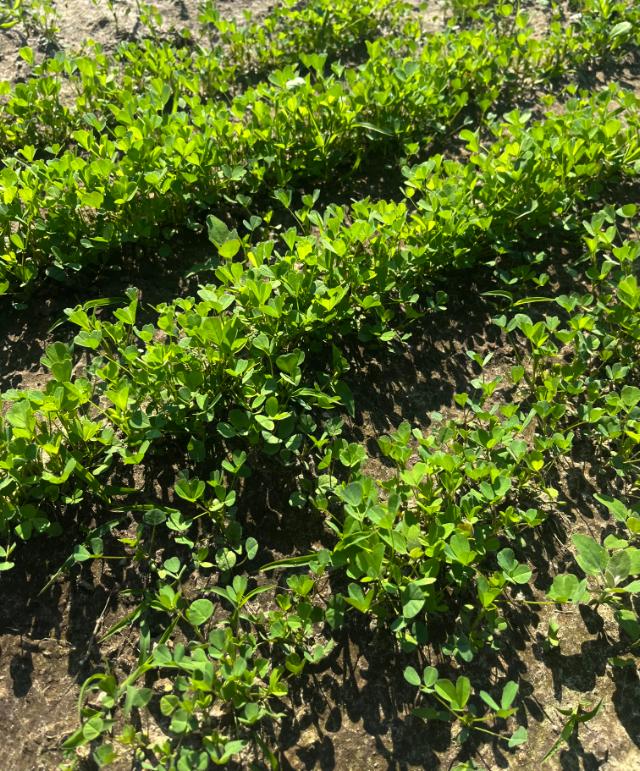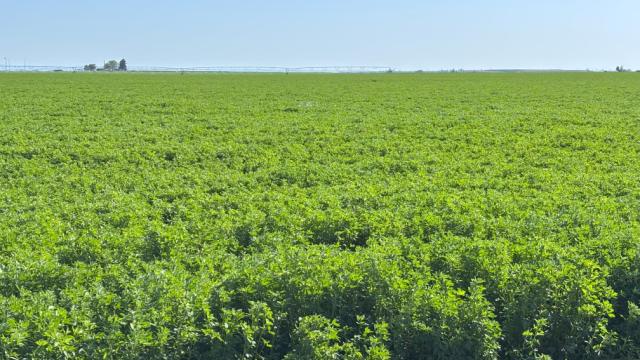Summer Seeding Alfalfa Advantages & Risks
Summer seeding of alfalfa can be successful if proper management techniques are applied. Let’s review the advantages, risks and
recommendations for establishing an alfalfa stand in late summer.

ADVANTAGES TO LATE SUMMER SEEDING
- Increased yield the first production year. Establishing stands in late summer typically leads to higher yields in the first production year since the plants have a longer period of time to get established. Yields are often more comparable to those of established alfalfa fields than to spring-planted ones, which typically take time to establish and are less productive in the first year.
- Fewer weeds and insect pressure. Alfalfa stands planted in late summer typically have less problems with both weeds and insects. There are less annual weeds to contend with and they will usually be killed by frost in the fall. Insect pressure may also be reduced with the arrival of colder temperatures.
- Warmer soil temperatures. Warmer soil temperatures make it easier to plant on heavy clay soils and help alfalfa seedlings establish quicker. In addition, growers are able to plant alfalfa stands in the fall without fear of planting delays due to cold soil temperatures and seedling diseases associated with wet spring weather, like Pythium, Phytophthora Root Rot, and Aphanomyces Root Rot
- Reduce your spring workload. Planting and establishing alfalfa in late summer allows you more time for other field work in the spring.
RISKS ASSOCIATED WITH LATE SUMMER SEEDING
- Adequate moisture. Adequate moisture is often the key factor that determines the success of a late summer planting. If the stand is planted but there is no moisture for a month or more, it can impact whether the plants will be mature enough to survive the winter. In most cases alfalfa plants need to be in the third trifoliate stage in order to have a chance to survive the winter.
- Early Frost. Early frost may damage the young seedlings before the plants have time to establish. Plants should have a minimum of 6-8 weeks of growth before a killing frost (4 hours at 26°F or below). This is extremely important when deciding to plant in higher elevations.
- Sclerotinia root rot. Sclerotinia root rot can impact alfalfa stands by weakening plant growth during establishment, particularly in areas with cool, wet conditions that favor disease development.
- Crop rotation. Late summer-planted alfalfa typically follows a small grain crop. In some cases, producers may consider planting alfalfa into an existing stand. If the stand is less than a year old, such as when a spring seeding failed to establish well, thickening the stand is generally not an issue. However, planting into stands more than a year old is not recommended due to the risk of autotoxicity, which can prevent new seedlings from establishing.
- Herbicide carryover. Check your previous crop herbicide residual intervals to make sure there will not be any problems of carryover herbicide injury. Many times these can have a major impact on stand establishment.
RECOMMENDATIONS FOR LATE SUMMER SEEDING
Alfalfa Pre-Plant Preparation
- Check previous crop herbicide intervals to make sure there will be no carryover problems.
- Take a soil test and apply soil amendments. For best performance, alfalfa prefers a soil pH range of 6.5-7.5. Generally, applications of either lime (to raise the pH) or sulfur (to lower the pH) should be applied the season before planting the alfalfa in order to allow sufficient time for the pH to adjust.
- Control perennial weeds like quackgrass, canada thistle, yellow nutsedge, dandelion, shepherd’s purse, pennycress, volunteer oats, winter wheat, and winter rye before planting alfalfa.
- Ground preparation for a late summer alfalfa planting should be done in a manner to conserve soil moisture. Adequate soil moisture is important for proper establishment in the fall. Firming the ground with a cultipacker or similar device immediately after ground prep will help preserve soil moisture.
- Having a firm seedbed is critical for stand establishment. Planting into a firm seedbed optimizes seed to soil contact for proper germination and establishment.
Planting Date
Late summer planting requires a minimum growth period of 6-8 weeks before a killing frost. Optimal planting dates will depend on the region or elevation.
Nurse Crop
Planting a nurse crop with a late summer seeding is generally not recommended due to limited soil moisture. Competition with the nurse crop may be detrimental to the alfalfa stand establishment.
Seeding Rate and Planting Depth
The recommended seeding rate for alfalfa is 18-25 lbs. per acre. The rate may vary depending on your local conditions, however the objective is to have 15-25 plants per square foot 5-6 weeks after planting. Higher seeding rates may be required if the soil conditions or planting methods are not optimal. Keep in mind that seeding at too low of a rate may limit the stand productivity over the life of the stand.
Planting depth for alfalfa is recommended at ¼ to ½ inch, however, this may vary depending on soil type and the availability of soil moisture. Planting too deep can hinder the establishment and productivity of the alfalfa stand.

